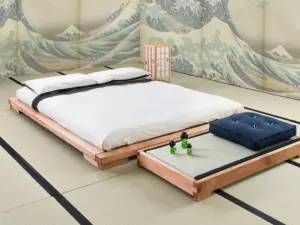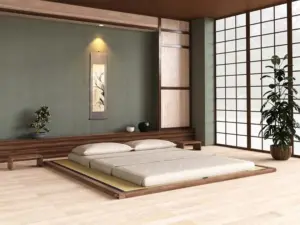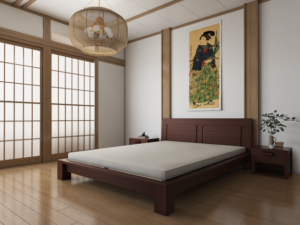Tatami Bed: Merging Japanese Tradition with Modern Comfort
The Tatami Bed, an elegant fixture in many contemporary bedrooms, offers a captivating blend of tradition, style, and comfort. Acting as a piece of history intertwined with modern utility, it’s more than just a simplistic sleeping arrangement. The enthralling allure of the Tatami Bed lies within its remarkable versatility, showcasing its ability to seamlessly fuse the past and present. Elegantly, it acts as a harmonious bridge, merging the ancient Japanese way of life with the modern aspirations of global citizens, cultivating a cultural synthesis.
Transitioning into modern times, the Tatami Bed of today reflects evolved aesthetics and improved techniques, yet it still tenderly carries with it centuries of culture, practices, and narratives. Delving into the rich history and the captivating evolution of the Tatami Bed is crucial, as it unveils its profound significance in today’s global furniture market, enriching our understanding and appreciation of this timeless piece. Through the lenses of time, the Tatami Bed remains a cherished emblem of a rich historical tapestry meeting modern elegance and functionality.
Origin and History Tatami Bed
The story of the Tatami begins in Japan, a country known for its rich cultural tapestry. Initially, Tatami mats were symbols of luxury and were accessible only to the nobility. As woven mats of straw, they were laid out in rooms where guests were received, setting the stage for important events and ceremonies. Over time, as its utility and benefits became widely acknowledged, it trickled down to common households, becoming an integral part of Japanese living.
Gradually, the mats transformed into beds. The transformation wasn’t just about the utility but also a societal change. As Japanese homes started adopting more minimalist designs, the Tatami Bed, with its simplicity and functionality, fit right in.
Modern Adaptation
In today’s globalized world, the Tatami Bed has crossed Japanese shores, finding admirers and enthusiasts across continents. The modern Tatami Bed is more than just woven straw. Many now come with wooden or metallic frames, enhanced ergonomics, and designs that cater to diverse tastes. Some even have storage solutions built in, providing utility beyond just sleep.
While the essence remains, today’s Tatami Bed is more adaptable. It can be found in both traditional Japanese homes and New York City apartments, proving its universal appeal. Its ability to blend in yet stand out makes it a favorite among interior designers worldwide.
What is a Tatami Bed?
A question often posed by those unfamiliar with Japanese culture or minimalist design principles. At its core, a Tatami Bed is a sleeping arrangement that emphasizes comfort, posture, and aesthetics. It’s a bed that’s low, close to the ground, often paired with a thin, comfortable mattress or futon.
Traditional Elements
Diving deep into its traditional elements, the Tatami Bed’s primary component is the woven straw mat. These mats, firm yet comfortable, provide the right balance, ensuring proper spinal alignment. Besides the health benefits, these mats are also eco-friendly, made from natural materials. The traditional Tatami Bed emphasized the principles of minimalist living — everything you need, nothing you don’t.
Contemporary Features
However, as times changed, so did the Tatami Bed. Today, while you can still find the classic design, many come with contemporary features. These could be in the form of varied materials, added storage spaces, or even designs that reflect modern aesthetics. Some Tatami Beds are even elevated, catering to those who might want the feel of a Tatami but prefer their beds a bit higher.
One of the most notable shifts has been in the materials used. While straw remains a popular choice, one can find Tatami Beds made of foam, synthetic materials, or a blend, catering to different preferences and budgets. With innovations in design and material, the Tatami Bed continues to be a relevant and sought-after piece of furniture in the modern world.
Benefits of a Tatami Bed
- Ergonomic Design: The flat and firm surface of the Tatami Bed promotes proper spinal alignment, helping prevent back and neck pain.
- Eco-friendly: Traditional Tatami Beds are made from natural materials like woven straw, making them environmentally sustainable.
- Space-Saving: Their minimalist design takes up less space, ideal for smaller rooms or apartments.
- Thermal Insulation: The straw mats of traditional Tatami Beds offer natural insulation, keeping you warmer during winters and cooler during summers.
- Aesthetic Appeal: With its simple and elegant design, a Tatami Bed adds a touch of Japanese aesthetic to any room, blending well with various decor styles.
- Versatility: It can be paired with a futon for sleeping and then rolled up during the day for extra space.
- Durability: If taken care of properly, Tatami Beds can last for years, with the straw mats becoming firmer and more comfortable over time.
- Natural and Hypoallergenic: Tatami mats are often resistant to allergens, making it a good choice for those with allergies or respiratory issues.
- Promotes Minimalist Living: The simplicity of the Tatami Bed design aligns well with minimalist living principles, encouraging decluttered spaces and mindful living.
- Cultural Experience: Owning a Tatami Bed offers a unique cultural experience, connecting you to centuries-old Japanese traditions.
Wyoming King Bed: An Ultimate Guide to Luxurious Sleep
Choosing the Right Tatami Bed
When you decide to integrate a piece of history, culture, and comfort into your bedroom by choosing a Tatami Bed, it’s vital to make the right choice. Picking the perfect Tatami Bed isn’t just about its aesthetics; it’s also about its function, fit, and durability. Here are some considerations to keep in mind:
- Size Matters: Begin with the basics. Measure the space where you plan to place the Tatami Bed. These beds come in various sizes – single, double, queen, and king. It’s crucial to choose one that will fit comfortably in your room without overwhelming the space.
- Material Quality: Traditional Tatami mats are made from woven straw, which is natural and eco-friendly. However, modern adaptations might use synthetic materials. Prioritize beds made with high-quality, authentic materials to ensure longevity and the genuine experience of sleeping on a Tatami.
- Frame Sturdiness: Check the frame’s material. Solid wood frames, like pine or oak, tend to be more durable and can support more weight than composite wood or particleboard.
- Aesthetic Preferences: The charm of the Tatami Bed lies in its unique appearance. Consider the color of the mats, the style of the frame, and how it complements your bedroom’s existing decor.
- Breathability: The woven design of traditional Tatami mats ensures good airflow, which is essential for regulating temperature. This is especially vital if you live in a humid area, as it prevents mold growth.
- Maintenance Requirements: Like any other bed, Tatami Beds require maintenance. Check how often the mats need to be aired out or whether any special cleaning products are needed. A bed that’s easier to maintain will serve you better in the long run.
- Compatibility with Mattresses: While Tatami Beds are often paired with futons, some people might want to use them with modern mattresses. Ensure the bed you choose is compatible with the type of mattress you want to use.
- Budget: As with any purchase, consider your budget. Tatami Beds can range in price, from very affordable to quite luxurious. It’s essential to find a balance between quality and what you’re willing to spend.
My Top Recommended
1. Vivere Zen YAMA
The Yama platform bed, crafted in a genuine Japanese style, is made from solid okumé wood. It offers the choice of rigid slats or tatami mats, enhancing its oriental allure. Prioritizing eco-friendliness, this bed uses interlocking wooden designs, avoiding metals. The bed employs organic, Italian-made paints, comprising natural oils and essences. The bed frame has specific dimensions, and with a recess of half an inch, traditional tatami mats will prominently protrude.

2. Vivere Zen HAKO
The Hako platform bed is an Italian-crafted piece made from premium solid wood and finished with linseed oil. Unique in design, its tatami mats lie directly on the floor, allowing individuals to walk on them barefoot. This bed distinguishes itself with a 5 cm thick frame on all sides, using only wood for its pin joint connections. The wide frame spans 25 cm on each side, standing at a height of 5.5 cm, level with the tatami. While the showcased Hako bed features solid walnut, customers can choose various wood types, all handpicked by the carpenter in line with Green Peace’s recommendations.

3. Raku Tatami Platform Bed
The Raku Tatami Platform bed stands out as an eco-friendly option in the world of furniture. Crafted from solid Para wood, it steers clear of harmful components like particle board, ensuring a healthier sleep environment. Notably, this wood is sustainably sourced, ensuring we’re not depleting our natural forests. The bed’s unique construction, which avoids typical warping and cracking, uses non-toxic wood glue on finger joints. This method allows the wood to naturally adjust to varying conditions, creating a more durable product. Additionally, with finishes free from off-gassing, sleepers won’t be exposed to unhealthy fumes. What’s truly innovative is its assembly method: the frame ditches traditional nails or screws, relying on a sturdy slot-locking system. This bed truly combines form, function, and environmental responsibility.

Maintenance and Care Tips
The allure of a Tatami Bed extends beyond its aesthetic appeal to its history and the craft behind it. Like any precious piece of furniture, it demands specific maintenance and care to preserve its uniqueness and ensure longevity. Being predominantly made from natural materials, a Tatami Bed, and particularly its mat, is susceptible to wear and tear. It requires a particular set of care practices different from your typical bed.
Every Tatami Bed tells a story, and to let this narrative continue, one must indulge in regular upkeep. For starters, regular airing out is a ritual that can’t be overlooked. This simple routine ensures that any accumulated moisture gets a chance to evaporate, maintaining the mat’s firmness and preventing mold formation. Moreover, while Tatami Beds are resilient, it’s advisable to rotate the mats every few months, especially if you often sit or lie down in a particular spot. This ensures even wear and maintains the bed’s uniform look.
Cleaning Essentials
For Tatami Beds, with their natural makeup, it’s best to avoid harsh chemicals and intense cleaning routines. Many Tatami Bed owners wonder about the best way to clean the mats. Vacuuming works well. Use a vacuum cleaner with a brush attachment and gently cover the mat’s surface to eliminate any dust or particles. Aim to do this once a week or even more, based on how often you use the bed.
If you spill something, act quickly. Blot the spill with a dry cloth without rubbing. If needed, follow up with a slightly damp cloth. Make sure you dry the mat completely to avoid mold. Remember, wet wipes, sprays, or other moisture-heavy products aren’t suitable for the mat.
Lifespan Enhancement
The journey of preserving a Tatami Bed revolves around extending its longevity while keeping its pristine quality intact. Regular cleaning is a given, yet there are other measures you can embrace. For instance, positioning the bed away from direct sunlight helps avert premature drying out or fading of the mats. Moreover, if your abode sits in a notably humid area, investing in a dehumidifier to keep room conditions optimal is a worthy consideration.
Additionally, a common oversight is neglecting the underside of the Tatami mats. Making a habit of flipping them occasionally ensures an even wear on both sides, which not only retains a consistent appearance but also adds to the mat’s lifespan. In case you pair the Tatami with a futon or mattress, airing it out routinely will thwart moisture buildup, contributing to a healthier sleep environment.
Above all, extending courtesy to your Tatami Bed is paramount. Refrain from jumping on it or exerting excessive pressure on specific parts. Adhering to these guidelines will not only prolong the life of your Tatami Bed but also preserve its allure for many years, potentially decades. As time unfolds, this humble bed may transcend its basic utility, morphing into a cherished heirloom that journeys through generations within your family.
Tatami in a Western Bedroom
Tatami Beds in Western bedrooms showcase the East meets West blend, combining minimalism with comfort. Western interiors, often spacious and ornate, now lean towards simplicity and functionality. Introducing a Tatami Bed creates a tranquil focal point. Additionally, setting a Tatami Bed on carpets or wooden floors offers a unique aesthetic mix. Pairing the bed with vibrant linens or throws can also elevate the room’s look.
Fusion Styles: Fusing Tatami Bed’s essence with Western designs offers vast design possibilities. Some maintain the Tatami’s minimalist vibe, adding small Western touches like decorative pillows. Others opt for a deeper fusion, like pairing the Tatami Bed with a plush headboard or modern furniture. These styles narrate a journey from traditional East to modern West.
Potential Hurdles: Navigating the market for an authentic Tatami Bed outside of Japan often presents a challenge to many. Although numerous “Tatami-style” beds abound, the real Tatami mats boast a unique feel and longevity that truly set them apart. Initially, you might need some time to adapt to the Tatami’s firmness, given that it offers a different sleeping surface compared to conventional mattresses. Furthermore, the bed’s organic nature means it responds to room humidity and temperature, calling for extra care in certain climates to maintain its integrity. On top of that, it’s wise to consider the height of other furniture in the room to ensure a harmonious match with the bed’s low profile, thereby creating a balanced and aesthetically pleasing space.




